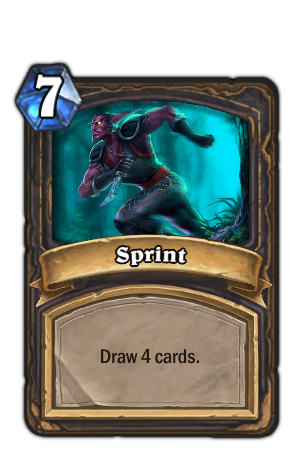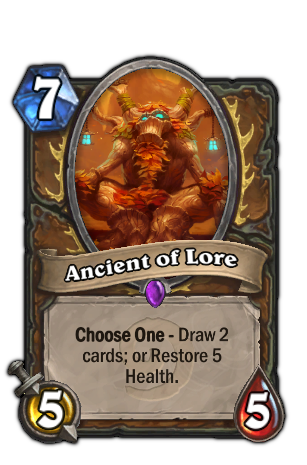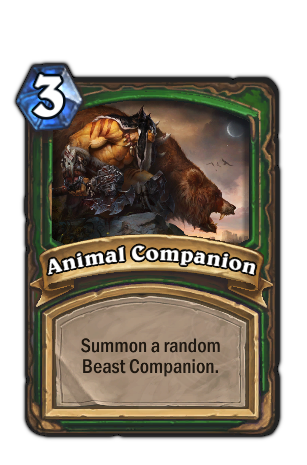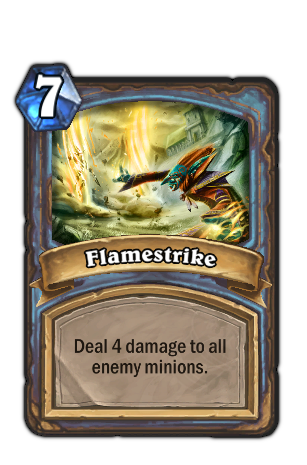As a reminder, this series of posts (part 1 here) will focus on predicting what cards will be changed, and for the ones most likely to change, what the predicted change will be.
In today's prediction of the Standard Format rebalancing, I cover three more classes in Hearthstone: Paladin, Priest and Rogue.
In the discussion below, I look at several potential problematic or more powerful cards in each of these classes, with a consideration of the current metagame and strong decks that will remain Standard Format legal when the first rotation happens this spring. I have endeavored to be conservative in picking cards for discussion, including more cards than not to try and identify all possible rebalancing angles.
(All card images herein contain copyrighted and other material owned by Blizzard Entertainment)
-----------------------
PALADIN
Overview - Long time Hearthstone players will recall that Paladin was one of the classes that struggled to find any consistent success on ladder before some course corrections were made in Goblins vs. Gnomes and Naxxramas. Unfortunately, with those cards leaving Standard Format (and most of the Secret Paladin deck with it), what is left may not be a solid base for future Standard decks. Indeed, outside the one legendary card available, almost everything else in Basic and Classic is pretty average and, in most cases, below par.
As a result, I will discuss only three cards here. The second one was picked over Consecration, but it shows that the class as a whole is pretty underpowered in these initial sets.
Divine Favor - Classic

Shout out to a law school friend Mike for pointing out my omission of this card in my first draft of this article. I had overlooked this card partially because it has proven to be a swing card that often does nothing, as much as it does great things, particularly outside of truly aggressive Paladin decks. This card was nerfed once already from 2 mana to 3, which lowers the likelihood it needs rebalanced again. On average, this probably nets 2 cards, which is in line with Arcane Intellect, the standard card draw engine of Mage. I think cards like this need to exist to balance out control strategies (which can still play around this card, for what it's worth), and given how weak Paladin is across the rest of Basic/Classic, the potential big swings of Divine Favor may not be too powerful. However, the fact that an aggressive Paladin deck can net 3 or more cards in one fell swoop with little downside does have the potential of making it difficult to encourage other types of Paladin strategies to be effective. If I've learned anything from other card games like Magic, it is that broken or potentially broken card draw engines tend to be the most disruptive and most likely to be banned/rebalanced. Thus, this card has to be on the short list for Blizzard, in all likelihood.
Likelihood of Rebalancing - Very likely, higher than 50%.
How to Rebalance - The only real option is to make the mana cost be prohibitive, preventing aggressive strategies from being able to reload and drop more threats on a single turn. Whether that means 5 mana or more, this card should find a significant bump in requirements (but the general concept of card draw based on the opponent is inventive, and should still remain until it proves broken at a higher mana cost, in my opinion).
Truesilver Champion - Basic
The better weapon given to Paladins as part of the Basic cards earned during leveling remains one of the best weapons for this class, outside the Ashbringer that comes out of Tirion Fordring. It is slightly more powerful than the basic Warrior weapons as far as benefit for cost, and more in line with Death's Bite, the most played Warrior weapon. However, this has not stifled interesting alternative weapon designs, including Sword of Justice and Coghammer, from also seeing play in competitive decks. In view of this, and the greater depth of weapons overall for Warrior, I do not see any reason that this card will see rebalancing.
Likelihood of Rebalancing - Slim to None.
Tirion Fordring - Classic

Much like with the only Legendary rarity card discussed in the first article of this series (Archmage Antonidas), Tirion has always been the best Paladin legendary card by a long shot. If an opponent does not save a silence for this minion, he likely will remove at least two creatures while then leaving a 5/3 Ashbringer weapon for the Paladin to do some serious damage with. The fact that all of these abilities can be largely nullified with a silence does help his cause for avoiding the rebalancing process, but it has become clear that it is difficult to make another Paladin creature be anywhere near as good. That could be a limit on design, albeit a very small one. If Paladin looks like it will remain a top deck in Standard in internal testing as it is right now with Secret Paladin, I expect this to be the sole Paladin card which will merit a slight reduction in power.
Likelihood of Rebalancing - 50/50.
How to Rebalance - Although we have yet to come to Big Game Hunter, if that is going to remain a thing in Standard, then maybe making Tirion a 7/5 would be a small enough change to make him vulnerable to yet another commonly-played foil or tech card. Alternatively, the Ashbringer could be modified to something a little weaker, like a 4/3 or a 6/2, to bring him closer in line with the strength of other good legendaries. I think the latter change is more likely, as the Ashbringer is really what puts this card over the top in my opinion, and that's only if the team wants to change this card.
-----------------------------------
PRIEST
Overview - Perhaps the only class consistently worse in constructed Hearthstone than Paladin over the first few months of the game was Priest. It was so bad that some pro players and streamers made a reputation out of figuring out how to win with this very underpowered set of class cards. That tends to indicate that there won't be anything to look at for rebalancing, especially using the assumption that no cards will be improved or "buff"-ed in this process. Until dragons became more powerful in more recent expansions that will remain Standard Format legal, Priest was not really a good place to be playing constructed.
However, just like for Paladin and Hunter before this, I have identified a few of the strongest cards that still find consistent play for discussion here. Really the only other card which merited any attention whatsoever was Mind Control, which was already nerfed a couple years ago from an 8-mana card to 10-mana, thereby leaving no actual room for further adjustment.
Northshire Cleric - Basic
Any card that has the potential of drawing multiple cards at a single time has the potential to be broken. One analogous card to Northshire Cleric in a much different setting was Starving Buzzard before it went from 2 mana to 5 mana over a year ago. Cleric tends to be a big enabler in Control Priest strategies, and until a 2/3 dragon for 1 was provided (for Dragon-based decks), this card saw no competition for the 1-drop spot of Priest decks except maybe for Zombie Chow. If Blizzard is rebalancing cards to try and force players to alter the sets of cards used in Standard Format, the ubiquitous nature of this card in Priest decks may mean it is time for a redesign to avoid having a low-cost creature be so game-altering in many match ups.
Likelihood of Rebalancing - 50/50.
How to Rebalance - If this card were to be included on a rebalancing, I would suspect a dramatic change like Starving Buzzard. The reason for this would be to open up the 1-mana slot for alternative Priest minion designs while also avoiding making the Cleric useless (which reducing the toughness statistic from 3 would likely do). Thus, a 3 mana 1/4 version of this creature would bring the power level down while maintaining the spirit of the card for a future generation, and it would also fill a gap left in the 3 mana slot that took forever to fix until Dark Cultist and Deathlord showed up, but botho f these are rotating back out of Standard.
Shadow Word: Death - Basic

This card is kind of a "feels bad man" card when the opponent spends a bunch of mana to put out a big creature only to have it nullified for three mana. But unlike the cries about Big Game Hunter, which does largely the same thing with a 4/2 body attached, this spell leaves no minion on board. That fact alone, and the fact that it is limited to a class all about control, means this card makes sense to keep alongside its counterpart Shadow Word: Pain, which kills small minions.
Likelihood of Rebalancing - Slim to None.
Cabal Shadow Priest - Classic

I'm not one for having to have gold cards, but just look at the nifty different art appearance on Cabal Shadow Priest. Anyway, this is yet another Priest card which nullifies or takes things away from the opponent. Combined with Shrinkmeister, this is an 8-mana Mind Control for any creature with 4 power or less, with a combined 7/7 of stats to boot across the other two creatures. But Shrinkmeister is gone in the new Standard as it is in Goblins vs. Gnomes, which may be the saving grace for this Priest epic. When limited to only creatures with less than 2 power, it is still a powerful card but not overwhelmingly so. Indeed, it is kind of like a smaller cousin to legendary Sylvanas Windrunner, and that's probably still OK even though it can be terribly annoying to play against with an aggressive deck.
Likelihood of Rebalancing - Not very likely, less than 50%.
--------------------------------
ROGUE
Overview - Unlike the other two classes discussed in this article, Rogue was one of the most successful and hated decks back when Classic and Basic made up a majority of the card pool for Hearthstone. Miracle Rogue was a dominant strategy in the hands of a great Rogue player, and it is one of the reasons cards like Loatheb became reality in Naxxramas. However, several cards enabling the combo finish of Miracle Rouge and the strong lead up to that have been nerfed already, including Gadgetzan Auctioneer and Leeroy Jenkins, among others.
That led Rogue to become much more reliant on tempo plays with the "combo" ability and finishing with different cards like Tinker's Sharpsword Oil, which, by the way, is gone in this rotation as well when the Standard Format begins. Thus, despite what may have been expected based on the history of the game to be a target class for rebalancing cards, there's not really a ton of problems here at the current juncture.
Backstab - Basic

One of the defining features of a Rogue other than weapon buffing is the Combo mechanic, and perhaps the biggest useful enabler of such tactics is this removal spell. While Druid and Priest have similar spells and have to pay 1 mana for a similar effect, Rogue gets it for free, but with the caveat that the 2 damage can only target minions, and undamaged minions at that. That and the investment of a card makes this spell pretty much in line with the power level of those other class removal options. Furthermore, Rogue would not be the same without some decent Combo enablers, so I suspect that will keep Backstab as a staple of this class for years to come without making any problems.
Likelihood of Rebalancing - Slim to None.
Preparation - Classic
The more interesting of the zero-mana Rogue cards to discuss is the epic rarity card Preparation, which also enables Combo as well as cheap big spells like Vanish and Sprint. Much like Backstab, this has become a staple support card for what Rogue is, and it is in line with other fast mana for a card spells like Innervate. While that is a high power level, it does not seem completely unreasonable when limited to spells which can largely only come from class cards currently. It is notable that this card escaped the hammer when other staples of Miracle Rogue did not in previous nerfs, so while I do think there's a non-zero chance this gets changed slightly, it is probably safe so long as we aren't overlooking a good Standard Format Rogue deck that has not been figured out beyond the existence of Oil Rogue right now.
Likelihood of Rebalancing - Not very likely, less than 50%.
Sprint - Basic

Again, a recurring theme of rebalancing is identifying cards which appear in almost every deck of a class, and also identifying types of cards (including drawing multiple cards at once) that tend to create the most problems in a card game. Sprint has the most raw power of card drawing in the game, but it also comes at a very steep cost. However, with the existence of Preparation in this class, the potential combination of these cards could prove to be slightly too powerful, at which point it would be likely to see this come down to 3 cards or go up in mana cost. For now, it's probably fine based on requiring two cards to be broken, but it is likely on a watch list for future rebalancing.
Likelihood of Rebalancing - Not very likely, less than 50%.
--------------------------------
All told, these second three classes have resulted in another three cards which I identify as at least 50/50 candidates for rebalancing, bringing the total up to 6 overall. It will be interesting to see if I overlooked any cards such as in Rogue, as the class was strong back when Classic and Basic made up a higher percentage of the card pool available.
Stay tuned for the next article in this series, where the final three classes will be discussed (and then later a look at neutral minions)! Please share your own thoughts on Paladin, Priest, and Rogue rebalancing in the comments below, as I'd love to hear feedback and differing opinions.






